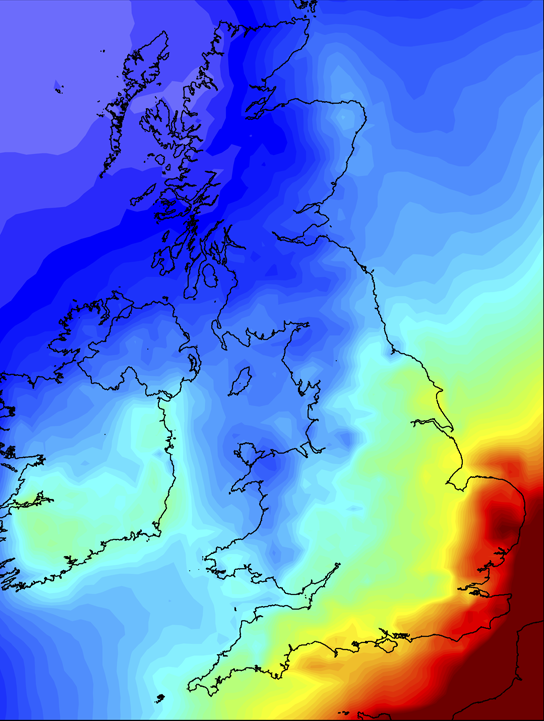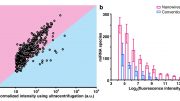
A map plots the distribution of combustion emissions that have migrated into the United Kingdom from the rest of Europe. Higher concentrations, in red, can be found on the outskirts of the country. Credit: Steven Barrett
Anyone that has every taken a bike ride, jogged or walked along a busy street knows how bad the air feels and smells and has probably had second thoughts about doing it again. Now a new study from MIT confirms what many people have thought, emissions from cars, trucks, planes and power plants are bad for our health and according to this study, cause thousands of premature deaths each year.
In a study appearing this month in the journal Environmental Science and Technology, MIT researchers report that emissions from cars, trucks, planes and power plants cause 13,000 premature deaths in the United Kingdom each year.
The researchers analyzed data from 2005, the most recent year for which information is available. They found that among the various sources of emissions in the country, car and truck exhaust was the single greatest contributor to premature death, affecting some 3,300 people per year. By comparison, the researchers note, fewer than 3,000 Britons died in road accidents in 2005.
The researchers found that emissions originating elsewhere in Europe cause an additional 6,000 early deaths in the U.K. annually; U.K. emissions that migrate outside the country, in turn, cause 3,100 premature deaths per year in other European Union nations. In some areas on the periphery of the U.K. — such as northern Scotland — almost all air pollution comes from the rest of Europe, the researchers say.
MIT’s Steven Barrett and his co-author Steve Yim began the study in light of recent events in the U.K.: London is currently in violation of air quality standards set by the E.U., and the British government may face significant E.U. fines if it fails to address its air pollution.
“We wanted to know if the responsibility to maintain air quality was matched by an ability to act or do something about it,” says Barrett, the Charles Stark Draper Assistant Professor of Aeronautics and Astronautics at MIT. “The results of the study indicate there is an asymmetry there.”
Dust in the wind
Barrett worked with MIT postdoc Steve Yim to analyze emissions data provided by the British government. The team divided the country’s emissions into sectors, including road transport; power generation; commercial, residential and agricultural sources; and other transport, such as shipping and aviation.
The group then simulated temperature and wind fields throughout the country using a weather research and forecasting model similar to those used to predict short-term weather. Barrett and Yim entered emissions data into the model to see how weather might disperse the emissions. They then ran another simulation — a chemistry transport model — to see how emissions from different sectors interacted.
Finally, the group overlaid their simulation results on population density maps to see which locations had the greatest long-term exposure to combustion emissions. Barrett observed that most of the emissions studied were composed of particles less than 2.5 microns in diameter, a size that epidemiologists have associated with premature death.
Hazy outlook
After road transport, the researchers found that emissions from shipping and aviation were the second greatest contributor to premature deaths, causing 1,800 early deaths annually, followed by power plant emissions, which cause an estimated 1,700 premature deaths each year.
Barrett and Yim found that power plant emissions have larger health impacts in northern England, where emissions from five major plants tend to congregate. In London, the researchers found that shipping and aviation emissions had a greater impact on health, possibly due to the proximity of major airports to the city.
Emissions from the country’s power plants, which are mostly northeast of major cities and emit pollution well above ground level, are less damaging to the general population than other sources of pollution, Barrett says. In contrast, he says emissions from cars and trucks, which occur closer to where people live and work, pose a more serious risk to human health.
“People have a number of risk factors in their life,” Barrett says. “Air pollution is another risk factor. And it can be significant, especially for people who live in cities.”
Fintan Hurley, scientific director of the Institute of Occupational Medicine in Edinburgh, Scotland, says the group’s findings provide a detailed analysis of the sources of air pollution in the country. Hurley led a similar study by the Committee on the Medical Effects of Air Pollution, and says Barrett’s results are in line with that analysis. The implications, he adds, go beyond Britain’s borders.
“It’s helpful to have a detailed analysis of effects in the U.K., but outdoor air pollution from combustion sources is an important public health issue worldwide,” Hurley says. “With outdoor air pollution everybody is exposed, because fine particles and gases also penetrate indoors. It’s possible for individuals to do some things to limit their personal exposures, but the main need is to act together to reduce emissions.”
Reference: “Public Health Impacts of Combustion Emissions in the United Kingdom” by Steve H. L. Yim and Steven R. H. Barrett, 21 March 2012, Environmental Science and Technology.
DOI: 10.1021/es2040416
The study was funded by the Engineering and Physical Sciences Research Council.









Be the first to comment on "Study Reports Air Pollution Causes Thousands of Premature Deaths Each Year"